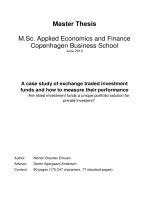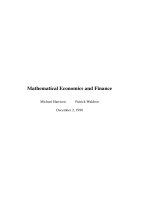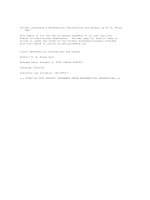Mathematical Economics and Finance ppt
Bạn đang xem bản rút gọn của tài liệu. Xem và tải ngay bản đầy đủ của tài liệu tại đây (1.33 MB, 153 trang )
Mathematical Economics and Finance
Michael Harrison Patrick Waldron
December 2, 1998
CONTENTS i
Contents
List of Tables iii
List of Figures v
PREFACE vii
What Is Economics? . . . . . . . . . . . . . . . . . . . . . . . . . . . vii
What Is Mathematics? . . . . . . . . . . . . . . . . . . . . . . . . . . . viii
NOTATION ix
I MATHEMATICS 1
1 LINEAR ALGEBRA 3
1.1 Introduction . . . . . . . . . . . . . . . . . . . . . . . . . . . . . 3
1.2 Systems of Linear Equations and Matrices . . . . . . . . . . . . . 3
1.3 Matrix Operations . . . . . . . . . . . . . . . . . . . . . . . . . . 7
1.4 Matrix Arithmetic . . . . . . . . . . . . . . . . . . . . . . . . . . 7
1.5 Vectors and Vector Spaces . . . . . . . . . . . . . . . . . . . . . 11
1.6 Linear Independence . . . . . . . . . . . . . . . . . . . . . . . . 12
1.7 Bases and Dimension . . . . . . . . . . . . . . . . . . . . . . . . 12
1.8 Rank . . . . . . . . . . . . . . . . . . . . . . . . . . . . . . . . . 13
1.9 Eigenvalues and Eigenvectors . . . . . . . . . . . . . . . . . . . . 14
1.10 Quadratic Forms . . . . . . . . . . . . . . . . . . . . . . . . . . 15
1.11 Symmetric Matrices . . . . . . . . . . . . . . . . . . . . . . . . . 15
1.12 Definite Matrices . . . . . . . . . . . . . . . . . . . . . . . . . . 15
2 VECTOR CALCULUS 17
2.1 Introduction . . . . . . . . . . . . . . . . . . . . . . . . . . . . . 17
2.2 Basic Topology . . . . . . . . . . . . . . . . . . . . . . . . . . . 17
2.3 Vector-valued Functions and Functions of Several Variables . . . 18
Revised: December 2, 1998
ii CONTENTS
2.4 Partial and Total Derivatives . . . . . . . . . . . . . . . . . . . . 20
2.5 The Chain Rule and Product Rule . . . . . . . . . . . . . . . . . 21
2.6 The Implicit Function Theorem . . . . . . . . . . . . . . . . . . . 23
2.7 Directional Derivatives . . . . . . . . . . . . . . . . . . . . . . . 24
2.8 Taylor’s Theorem: Deterministic Version . . . . . . . . . . . . . 25
2.9 The Fundamental Theorem of Calculus . . . . . . . . . . . . . . 26
3 CONVEXITY AND OPTIMISATION 27
3.1 Introduction . . . . . . . . . . . . . . . . . . . . . . . . . . . . . 27
3.2 Convexity and Concavity . . . . . . . . . . . . . . . . . . . . . . 27
3.2.1 Definitions . . . . . . . . . . . . . . . . . . . . . . . . . 27
3.2.2 Properties of concave functions . . . . . . . . . . . . . . 29
3.2.3 Convexity and differentiability . . . . . . . . . . . . . . . 30
3.2.4 Variations on the convexity theme . . . . . . . . . . . . . 34
3.3 Unconstrained Optimisation . . . . . . . . . . . . . . . . . . . . 39
3.4 Equality Constrained Optimisation:
The Lagrange Multiplier Theorems . . . . . . . . . . . . . . . . . 43
3.5 Inequality Constrained Optimisation:
The Kuhn-Tucker Theorems . . . . . . . . . . . . . . . . . . . . 50
3.6 Duality . . . . . . . . . . . . . . . . . . . . . . . . . . . . . . . 58
II APPLICATIONS 61
4 CHOICE UNDER CERTAINTY 63
4.1 Introduction . . . . . . . . . . . . . . . . . . . . . . . . . . . . . 63
4.2 Definitions . . . . . . . . . . . . . . . . . . . . . . . . . . . . . . 63
4.3 Axioms . . . . . . . . . . . . . . . . . . . . . . . . . . . . . . . 66
4.4 Optimal Response Functions:
Marshallian and Hicksian Demand . . . . . . . . . . . . . . . . . 69
4.4.1 The consumer’s problem . . . . . . . . . . . . . . . . . . 69
4.4.2 The No Arbitrage Principle . . . . . . . . . . . . . . . . . 70
4.4.3 Other Properties of Marshallian demand . . . . . . . . . . 71
4.4.4 The dual problem . . . . . . . . . . . . . . . . . . . . . . 72
4.4.5 Properties of Hicksian demands . . . . . . . . . . . . . . 73
4.5 Envelope Functions:
Indirect Utility and Expenditure . . . . . . . . . . . . . . . . . . 73
4.6 Further Results in Demand Theory . . . . . . . . . . . . . . . . . 75
4.7 General Equilibrium Theory . . . . . . . . . . . . . . . . . . . . 78
4.7.1 Walras’ law . . . . . . . . . . . . . . . . . . . . . . . . . 78
4.7.2 Brouwer’s fixed point theorem . . . . . . . . . . . . . . . 78
Revised: December 2, 1998
CONTENTS iii
4.7.3 Existence of equilibrium . . . . . . . . . . . . . . . . . . 78
4.8 The Welfare Theorems . . . . . . . . . . . . . . . . . . . . . . . 78
4.8.1 The Edgeworth box . . . . . . . . . . . . . . . . . . . . . 78
4.8.2 Pareto efficiency . . . . . . . . . . . . . . . . . . . . . . 78
4.8.3 The First Welfare Theorem . . . . . . . . . . . . . . . . . 79
4.8.4 The Separating Hyperplane Theorem . . . . . . . . . . . 80
4.8.5 The Second Welfare Theorem . . . . . . . . . . . . . . . 80
4.8.6 Complete markets . . . . . . . . . . . . . . . . . . . . . 82
4.8.7 Other characterizations of Pareto efficient allocations . . . 82
4.9 Multi-period General Equilibrium . . . . . . . . . . . . . . . . . 84
5 CHOICE UNDER UNCERTAINTY 85
5.1 Introduction . . . . . . . . . . . . . . . . . . . . . . . . . . . . . 85
5.2 Review of Basic Probability . . . . . . . . . . . . . . . . . . . . 85
5.3 Taylor’s Theorem: Stochastic Version . . . . . . . . . . . . . . . 88
5.4 Pricing State-Contingent Claims . . . . . . . . . . . . . . . . . . 88
5.4.1 Completion of markets using options . . . . . . . . . . . 90
5.4.2 Restrictions on security values implied by allocational ef-
ficiency and covariance with aggregate consumption . . . 91
5.4.3 Completing markets with options on aggregate consumption 92
5.4.4 Replicating elementary claims with a butterfly spread . . . 93
5.5 The Expected Utility Paradigm . . . . . . . . . . . . . . . . . . . 93
5.5.1 Further axioms . . . . . . . . . . . . . . . . . . . . . . . 93
5.5.2 Existence of expected utility functions . . . . . . . . . . . 95
5.6 Jensen’s Inequality and Siegel’s Paradox . . . . . . . . . . . . . . 97
5.7 Risk Aversion . . . . . . . . . . . . . . . . . . . . . . . . . . . . 99
5.8 The Mean-Variance Paradigm . . . . . . . . . . . . . . . . . . . 102
5.9 The Kelly Strategy . . . . . . . . . . . . . . . . . . . . . . . . . 103
5.10 Alternative Non-Expected Utility Approaches . . . . . . . . . . . 104
6 PORTFOLIO THEORY 105
6.1 Introduction . . . . . . . . . . . . . . . . . . . . . . . . . . . . . 105
6.2 Notation and preliminaries . . . . . . . . . . . . . . . . . . . . . 105
6.2.1 Measuring rates of return . . . . . . . . . . . . . . . . . . 105
6.2.2 Notation . . . . . . . . . . . . . . . . . . . . . . . . . . 108
6.3 The Single-period Portfolio Choice Problem . . . . . . . . . . . . 110
6.3.1 The canonical portfolio problem . . . . . . . . . . . . . . 110
6.3.2 Risk aversion and portfolio composition . . . . . . . . . . 112
6.3.3 Mutual fund separation . . . . . . . . . . . . . . . . . . . 114
6.4 Mathematics of the Portfolio Frontier . . . . . . . . . . . . . . . 116
Revised: December 2, 1998
iv CONTENTS
6.4.1 The portfolio frontier in
N
:
risky assets only . . . . . . . . . . . . . . . . . . . . . . 116
6.4.2 The portfolio frontier in mean-variance space:
risky assets only . . . . . . . . . . . . . . . . . . . . . . 124
6.4.3 The portfolio frontier in
N
:
riskfree and risky assets . . . . . . . . . . . . . . . . . . 129
6.4.4 The portfolio frontier in mean-variance space:
riskfree and risky assets . . . . . . . . . . . . . . . . . . 129
6.5 Market Equilibrium and the CAPM . . . . . . . . . . . . . . . . 130
6.5.1 Pricing assets and predicting security returns . . . . . . . 130
6.5.2 Properties of the market portfolio . . . . . . . . . . . . . 131
6.5.3 The zero-beta CAPM . . . . . . . . . . . . . . . . . . . . 131
6.5.4 The traditional CAPM . . . . . . . . . . . . . . . . . . . 132
7 INVESTMENT ANALYSIS 137
7.1 Introduction . . . . . . . . . . . . . . . . . . . . . . . . . . . . . 137
7.2 Arbitrage and Pricing Derivative Securities . . . . . . . . . . . . 137
7.2.1 The binomial option pricing model . . . . . . . . . . . . 137
7.2.2 The Black-Scholes option pricing model . . . . . . . . . . 137
7.3 Multi-period Investment Problems . . . . . . . . . . . . . . . . . 140
7.4 Continuous Time Investment Problems . . . . . . . . . . . . . . . 140
Revised: December 2, 1998
LIST OF TABLES v
List of Tables
3.1 Sign conditions for inequality constrained optimisation . . . . . . 51
5.1 Payoffs for Call Options on the Aggregate Consumption . . . . . 92
6.1 The effect of an interest rate of 10% per annum at different fre-
quencies of compounding. . . . . . . . . . . . . . . . . . . . . . 106
6.2 Notation for portfolio choice problem . . . . . . . . . . . . . . . 108
Revised: December 2, 1998
vi LIST OF TABLES
Revised: December 2, 1998
LIST OF FIGURES vii
List of Figures
Revised: December 2, 1998
viii LIST OF FIGURES
Revised: December 2, 1998
PREFACE ix
PREFACE
This book is based on courses MA381 and EC3080, taught at Trinity College
Dublin since 1992.
Comments on content and presentation in the present draft are welcome for the
benefit of future generations of students.
An electronic version of this book (in L
A
T
E
X) is available on the World Wide
Web at />although it may not always be the current version.
The book is not intended as a substitute for students’ own lecture notes. In particu-
lar, many examples and diagrams are omitted and some material may be presented
in a different sequence from year to year.
In recent years, mathematics graduates have been increasingly expected to have
additional skills in practical subjects such as economics and finance, while eco-
nomics graduates have been expected to have an increasingly strong grounding in
mathematics. The increasing need for those working in economics and finance to
have a strong grounding in mathematics has been highlighted by such layman’s
guides as ?, ?, ? (adapted from ?) and ?. In the light of these trends, the present
book is aimed at advanced undergraduate students of either mathematics or eco-
nomics who wish to branch out into the other subject.
The present version lacks supporting materials in Mathematica or Maple, such as
are provided with competing works like ?.
Before starting to work through this book, mathematics students should think
about the nature, subject matter and scientific methodology of economics while
economics students should think about the nature, subject matter and scientific
methodology of mathematics. The following sections briefly address these ques-
tions from the perspective of the outsider.
What Is Economics?
This section will consist of a brief verbal introduction to economics for mathe-
maticians and an outline of the course.
Revised: December 2, 1998
x PREFACE
What is economics?
1. Basic microeconomics is about the allocation of wealth or expenditure among
different physical goods. This gives us relative prices.
2. Basic finance is about the allocation of expenditure across two or more time
periods. This gives us the term structure of interest rates.
3. The next step is the allocation of expenditure across (a finite number or a
continuum of) states of nature. This gives us rates of return on risky assets,
which are random variables.
Then we can try to combine 2 and 3.
Finally we can try to combine 1 and 2 and 3.
Thus finance is just a subset of micoreconomics.
What do consumers do?
They maximise ‘utility’ given a budget constraint, based on prices and income.
What do firms do?
They maximise profits, given technological constraints (and input and output prices).
Microeconomics is ultimately the theory of the determination of prices by the in-
teraction of all these decisions: all agents simultaneously maximise their objective
functions subject to market clearing conditions.
What is Mathematics?
This section will have all the stuff about logic and proof and so on moved into it.
Revised: December 2, 1998
NOTATION xi
NOTATION
Throughout the book, x etc. will denote points of
n
for n > 1 and x etc. will
denote points of or of an arbitrary vector or metric space X. X will generally
denote a matrix.
Readers should be familiar with the symbols ∀ and ∃ and with the expressions
‘such that’ and ‘subject to’ and also with their meaning and use, in particular
with the importance of presenting the parts of a definition in the correct order
and with the process of proving a theorem by arguing from the assumptions to the
conclusions. Proof by contradiction and proof by contrapositive are also assumed.
There is a book on proofs by Solow which should be referred to here.
1
N
+
≡
x ∈
N
: x
i
≥ 0, i = 1, . . . , N
is used to denote the non-negative or-
thant of
N
, and
N
++
≡
x ∈
N
: x
i
> 0, i = 1, . . . , N
used to denote the
positive orthant.
is the symbol which will be used to denote the transpose of a vector or a matrix.
1
Insert appropriate discussion of all these topics here.
Revised: December 2, 1998
xii NOTATION
Revised: December 2, 1998
1
Part I
MATHEMATICS
Revised: December 2, 1998
CHAPTER 1. LINEAR ALGEBRA 3
Chapter 1
LINEAR ALGEBRA
1.1 Introduction
[To be written.]
1.2 Systems of Linear Equations and Matrices
Why are we interested in solving simultaneous equations?
We often have to find a point which satisfies more than one equation simultane-
ously, for example when finding equilibrium price and quantity given supply and
demand functions.
• To be an equilibrium, the point (Q, P) must lie on both the supply and
demand curves.
• Now both supply and demand curves can be plotted on the same diagram
and the point(s) of intersection will be the equilibrium (equilibria):
• solving for equilibrium price and quantity is just one of many examples of
the simultaneous equations problem
• The ISLM model is another example which we will soon consider at length.
• We will usually have many relationships between many economic variables
defining equilibrium.
The first approach to simultaneous equations is the equation counting approach:
Revised: December 2, 1998
4 1.2. SYSTEMS OF LINEAR EQUATIONS AND MATRICES
• a rough rule of thumb is that we need the same number of equations as
unknowns
• this is neither necessary nor sufficient for existence of a unique solution,
e.g.
– fewer equations than unknowns, unique solution:
x
2
+ y
2
= 0 ⇒ x = 0, y = 0
– same number of equations and unknowns but no solution (dependent
equations):
x + y = 1
x + y = 2
– more equations than unknowns, unique solution:
x = y
x + y = 2
x − 2y + 1 = 0
⇒ x = 1, y = 1
Now consider the geometric representation of the simultaneous equation problem,
in both the generic and linear cases:
• two curves in the coordinate plane can intersect in 0, 1 or more points
• two surfaces in 3D coordinate space typically intersect in a curve
• three surfaces in 3D coordinate space can intersect in 0, 1 or more points
• a more precise theory is needed
There are three types of elementary row operations which can be performed on a
system of simultaneous equations without changing the solution(s):
1. Add or subtract a multiple of one equation to or from another equation
2. Multiply a particular equation by a non-zero constant
3. Interchange two equations
Revised: December 2, 1998
CHAPTER 1. LINEAR ALGEBRA 5
Note that each of these operations is reversible (invertible).
Our strategy, roughly equating to Gaussian elimination involves using elementary
row operations to perform the following steps:
1. (a) Eliminate the first variable from all except the first equation
(b) Eliminate the second variable from all except the first two equations
(c) Eliminate the third variable from all except the first three equations
(d) &c.
2. We end up with only one variable in the last equation, which is easily solved.
3. Then we can substitute this solution in the second last equation and solve
for the second last variable, and so on.
4. Check your solution!!
Now, let us concentrate on simultaneous linear equations:
(2 × 2 EXAMPLE)
x + y = 2 (1.2.1)
2y −x = 7 (1.2.2)
• Draw a picture
• Use the Gaussian elimination method instead of the following
• Solve for x in terms of y
x = 2 − y
x = 2y −7
• Eliminate x
2 − y = 2y −7
• Find y
3y = 9
y = 3
• Find x from either equation:
x = 2 − y = 2 − 3 = −1
x = 2y −7 = 6 −7 = −1
Revised: December 2, 1998
6 1.2. SYSTEMS OF LINEAR EQUATIONS AND MATRICES
SIMULTANEOUS LINEAR EQUATIONS (3 × 3 EXAMPLE)
• Consider the general 3D picture
• Example:
x + 2y + 3z = 6 (1.2.3)
4x + 5y + 6z = 15 (1.2.4)
7x + 8y + 10z = 25 (1.2.5)
• Solve one equation (1.2.3) for x in terms of y and z:
x = 6 − 2y − 3z
• Eliminate x from the other two equations:
4 (6 − 2y −3z) + 5y + 6z = 15
7 (6 − 2y −3z) + 8y + 10z = 25
• What remains is a 2 ×2 system:
−3y −6z = −9
−6y −11z = −17
• Solve each equation for y:
y = 3 − 2z
y =
17
6
−
11
6
z
• Eliminate y:
3 − 2z =
17
6
−
11
6
z
• Find z:
1
6
=
1
6
z
z = 1
• Hence y = 1 and x = 1.
Revised: December 2, 1998
CHAPTER 1. LINEAR ALGEBRA 7
1.3 Matrix Operations
We motivate the need for matrix algebra by using it as a shorthand for writing
systems of linear equations, such as those considered above.
• The steps taken to solve simultaneous linear equations involve only the co-
efficients so we can use the following shorthand to represent the system of
equations used in our example:
This is called a matrix, i.e.— a rectangular array of numbers.
• We use the concept of the elementary matrix to summarise the elementary
row operations carried out in solving the original equations:
(Go through the whole solution step by step again.)
• Now the rules are
– Working column by column from left to right, change all the below
diagonal elements of the matrix to zeroes
– Working row by row from bottom to top, change the right of diagonal
elements to 0 and the diagonal elements to 1
– Read off the solution from the last column.
• Or we can reorder the steps to give the Gaussian elimination method:
column by column everywhere.
1.4 Matrix Arithmetic
• Two n ×m matrices can be added and subtracted element by element.
• There are three notations for the general 3×3 system of simultaneous linear
equations:
1. ‘Scalar’ notation:
a
11
x
1
+ a
12
x
2
+ a
13
x
3
= b
1
a
21
x
1
+ a
22
x
2
+ a
23
x
3
= b
2
a
31
x
1
+ a
32
x
2
+ a
33
x
3
= b
3
Revised: December 2, 1998
8 1.4. MATRIX ARITHMETIC
2. ‘Vector’ notation without factorisation:
a
11
x
1
+ a
12
x
2
+ a
13
x
3
a
21
x
1
+ a
22
x
2
+ a
23
x
3
a
31
x
1
+ a
32
x
2
+ a
33
x
3
=
b
1
b
2
b
3
3. ‘Vector’ notation with factorisation:
a
11
a
12
a
13
a
21
a
22
a
23
a
31
a
32
a
33
x
1
x
2
x
3
=
b
1
b
2
b
3
It follows that:
a
11
a
12
a
13
a
21
a
22
a
23
a
31
a
32
a
33
x
1
x
2
x
3
=
a
11
x
1
+ a
12
x
2
+ a
13
x
3
a
21
x
1
+ a
22
x
2
+ a
23
x
3
a
31
x
1
+ a
32
x
2
+ a
33
x
3
• From this we can deduce the general multiplication rules:
The ijth element of the matrix product AB is the product of the
ith row of A and the jth column of B.
A row and column can only be multiplied if they are the same
‘length.’
In that case, their product is the sum of the products of corre-
sponding elements.
Two matrices can only be multiplied if the number of columns
(i.e. the row lengths) in the first equals the number of rows (i.e.
the column lengths) in the second.
• The scalar product of two vectors in
n
is the matrix product of one written
as a row vector (1×n matrix) and the other written as a column vector (n×1
matrix).
• This is independent of which is written as a row and which is written as a
column.
So we have C = AB if and only if c
ij
=
k = 1
n
a
ik
b
kj
.
Note that multiplication is associative but not commutative.
Other binary matrix operations are addition and subtraction.
Addition is associative and commutative. Subtraction is neither.
Matrices can also be multiplied by scalars.
Both multiplications are distributive over addition.
Revised: December 2, 1998
CHAPTER 1. LINEAR ALGEBRA 9
We now move on to unary operations.
The additive and multiplicative identity matrices are respectively 0 and I
n
≡
δ
i
j
.
−A and A
−1
are the corresponding inverse. Only non-singular matrices have
multiplicative inverses.
Finally, we can interpret matrices in terms of linear transformations.
• The product of an m ×n matrix and an n × p matrix is an m × p matrix.
• The product of an m ×n matrix and an n × 1 matrix (vector) is an m × 1
matrix (vector).
• So every m × n matrix, A, defines a function, known as a linear transfor-
mation,
T
A
:
n
→
m
: x → Ax,
which maps n−dimensional vectors to m−dimensional vectors.
• In particular, an n×n square matrix defines a linear transformation mapping
n−dimensional vectors to n−dimensional vectors.
• The system of n simultaneous linear equations in n unknowns
Ax = b
has a unique solution ∀b if and only if the corresponding linear transfor-
mation T
A
is an invertible or bijective function: A is then said to be an
invertible matrix.
A matrix has an inverse if and only the corresponding linear transformation is an
invertible function:
• Suppose Ax = b
0
does not have a unique solution. Say it has two distinct
solutions, x
1
and x
2
(x
1
= x
2
):
Ax
1
= b
0
Ax
2
= b
0
This is the same thing as saying that the linear transformation T
A
is not
injective, as it maps both x
1
and x
2
to the same image.
• Then whenever x is a solution of Ax = b:
A (x + x
1
− x
2
) = Ax + Ax
1
− Ax
2
= b + b
0
− b
0
= b,
so x + x
1
− x
2
is another, different, solution to Ax = b.
Revised: December 2, 1998
10 1.4. MATRIX ARITHMETIC
• So uniqueness of solution is determined by invertibility of the coefficient
matrix A independent of the right hand side vector b.
• If A is not invertible, then there will be multiple solutions for some values
of b and no solutions for other values of b.
So far, we have seen two notations for solving a system of simultaneous linear
equations, both using elementary row operations.
1. We applied the method to scalar equations (in x, y and z).
2. We then applied it to the augmented matrix (A b) which was reduced to the
augmented matrix (I x).
Now we introduce a third notation.
3. Each step above (about six of them depending on how things simplify)
amounted to premultiplying the augmented matrix by an elementary ma-
trix, say
E
6
E
5
E
4
E
3
E
2
E
1
(A b) = (I x) . (1.4.1)
Picking out the first 3 columns on each side:
E
6
E
5
E
4
E
3
E
2
E
1
A = I. (1.4.2)
We define
A
−1
≡ E
6
E
5
E
4
E
3
E
2
E
1
. (1.4.3)
And we can use Gaussian elimination in turn to solve for each of the columns
of the inverse, or to solve for the whole thing at once.
Lots of properties of inverses are listed in MJH’s notes (p.A7?).
The transpose is A
, sometimes denoted A
or A
t
.
A matrix is symmetric if it is its own transpose; skewsymmetric if A
= −A.
Note that
A
−1
= (A
−1
)
.
Lots of strange things can happen in matrix arithmetic.
We can have AB = 0 even if A = 0 and B = 0.
Definition 1.4.1 orthogonal rows/columns
Definition 1.4.2 idempotent matrix A
2
= A
Definition 1.4.3 orthogonal
1
matrix A
= A
−1
.
Definition 1.4.4 partitioned matrices
Definition 1.4.5 determinants
Definition 1.4.6 diagonal, triangular and scalar matrices
1
This is what ? calls something that it seems more natural to call an orthonormal matrix.
Revised: December 2, 1998
CHAPTER 1. LINEAR ALGEBRA 11
1.5 Vectors and Vector Spaces
Definition 1.5.1 A vector is just an n ×1 matrix.
The Cartesian product of n sets is just the set of ordered n-tuples where the ith
component of each n-tuple is an element of the ith set.
The ordered n-tuple (x
1
, x
2
, . . . , x
n
) is identified with the n × 1 column vector
x
1
x
2
.
.
.
x
n
.
Look at pictures of points in
2
and
3
and think about extensions to
n
.
Another geometric interpretation is to say that a vector is an entity which has both
magnitude and direction, while a scalar is a quantity that has magnitude only.
Definition 1.5.2 A real (or Euclidean) vector space is a set (of vectors) in which
addition and scalar multiplication (i.e. by real numbers) are defined and satisfy
the following axioms:
1. copy axioms from simms 131 notes p.1
There are vector spaces over other fields, such as the complex numbers.
Other examples are function spaces, matrix spaces.
On some vector spaces, we also have the notion of a dot product or scalar product:
u.v ≡ u
v
The Euclidean norm of u is
√
u.u ≡ u .
A unit vector is defined in the obvious way unit norm.
The distance between two vectors is just u −v .
There are lots of interesting properties of the dot product (MJH’s theorem 2).
We can calculate the angle between two vectors using a geometric proof based on
the cosine rule.
v − u
2
= (v − u) . (v − u) (1.5.1)
= v
2
+ u
2
−2v.u (1.5.2)
= v
2
+ u
2
−2 v u cos θ (1.5.3)
Two vectors are orthogonal if and only if the angle between them is zero.
Revised: December 2, 1998
12 1.6. LINEAR INDEPENDENCE
A subspace is a subset of a vector space which is closed under addition and scalar
multiplication.
For example, consider row space, column space, solution space, orthogonal com-
plement.
1.6 Linear Independence
Definition 1.6.1 The vectors x
1
, x
2
, x
3
, . . . , x
r
∈
n
are linearly independent if
and only if
r
i=1
α
i
x
i
= 0 ⇒ α
i
= 0∀i.
Otherwise, they are linearly dependent.
Give examples of each, plus the standard basis.
If r > n, then the vectors must be linearly dependent.
If the vectors are orthonormal, then they must be linearly independent.
1.7 Bases and Dimension
A basis for a vector space is a set of vectors which are linearly independent and
which span or generate the entire space.
Consider the standard bases in
2
and
n
.
Any two non-collinear vectors in
2
form a basis.
A linearly independent spanning set is a basis for the subspace which it generates.
Proof of the next result requires stuff that has not yet been covered.
If a basis has n elements then any set of more than n elements is linearly dependent
and any set of less than n elements doesn’t span.
Or something like that.
Definition 1.7.1 The dimension of a vector space is the (unique) number of vec-
tors in a basis. The dimension of the vector space {0} is zero.
Definition 1.7.2 Orthogonal complement
Decomposition into subspace and its orthogonal complement.
Revised: December 2, 1998









